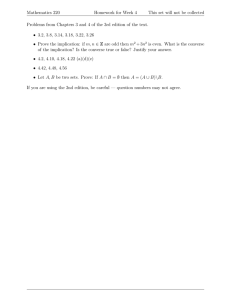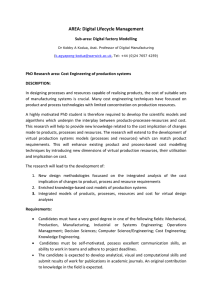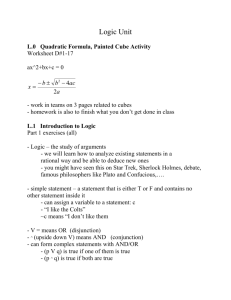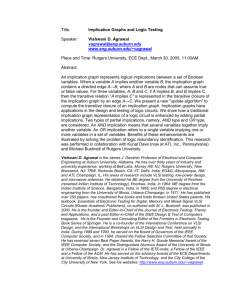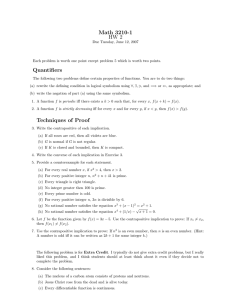Document 13136436
advertisement
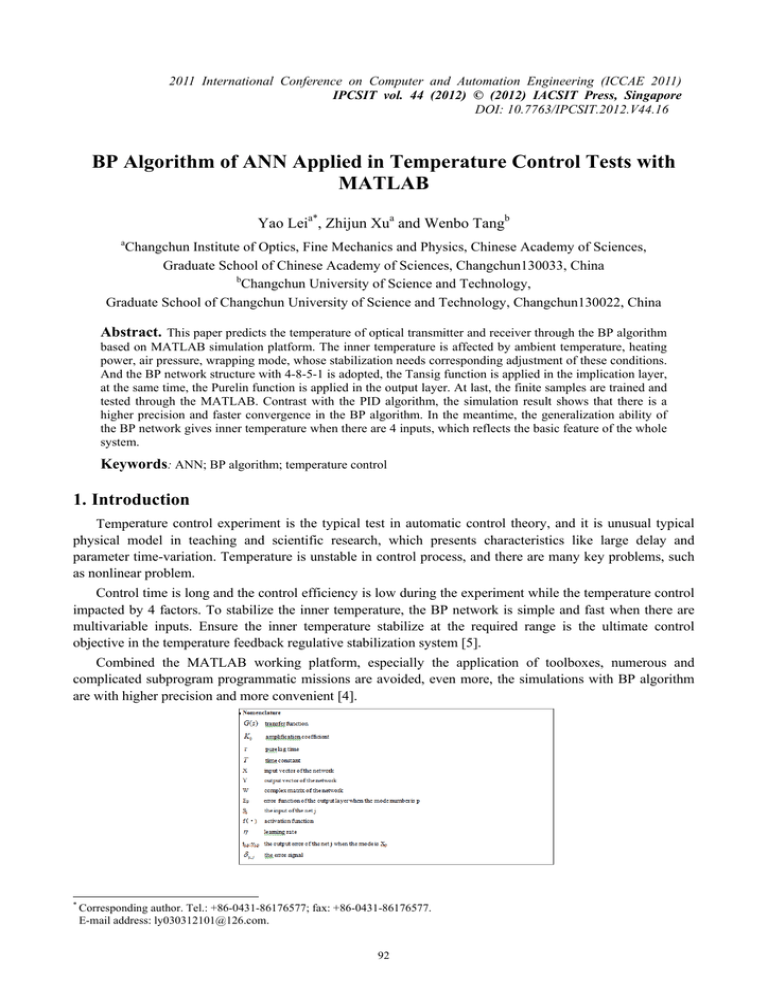
2011 International Conference on Computer and Automation Engineering (ICCAE 2011) IPCSIT vol. 44 (2012) © (2012) IACSIT Press, Singapore DOI: 10.7763/IPCSIT.2012.V44.16 BP Algorithm of ANN Applied in Temperature Control Tests with MATLAB Yao Leia*, Zhijun Xua and Wenbo Tangb a Changchun Institute of Optics, Fine Mechanics and Physics, Chinese Academy of Sciences, Graduate School of Chinese Academy of Sciences, Changchun130033, China b Changchun University of Science and Technology, Graduate School of Changchun University of Science and Technology, Changchun130022, China Abstract. This paper predicts the temperature of optical transmitter and receiver through the BP algorithm based on MATLAB simulation platform. The inner temperature is affected by ambient temperature, heating power, air pressure, wrapping mode, whose stabilization needs corresponding adjustment of these conditions. And the BP network structure with 4-8-5-1 is adopted, the Tansig function is applied in the implication layer, at the same time, the Purelin function is applied in the output layer. At last, the finite samples are trained and tested through the MATLAB. Contrast with the PID algorithm, the simulation result shows that there is a higher precision and faster convergence in the BP algorithm. In the meantime, the generalization ability of the BP network gives inner temperature when there are 4 inputs, which reflects the basic feature of the whole system. Keywords: ANN; BP algorithm; temperature control 1. Introduction Temperature control experiment is the typical test in automatic control theory, and it is unusual typical physical model in teaching and scientific research, which presents characteristics like large delay and parameter time-variation. Temperature is unstable in control process, and there are many key problems, such as nonlinear problem. Control time is long and the control efficiency is low during the experiment while the temperature control impacted by 4 factors. To stabilize the inner temperature, the BP network is simple and fast when there are multivariable inputs. Ensure the inner temperature stabilize at the required range is the ultimate control objective in the temperature feedback regulative stabilization system [5]. Combined the MATLAB working platform, especially the application of toolboxes, numerous and complicated subprogram programmatic missions are avoided, even more, the simulations with BP algorithm are with higher precision and more convenient [4]. * Corresponding author. Tel.: +86-0431-86176577; fax: +86-0431-86176577. E-mail address: ly030312101@126.com. 92 2. BP Algorithm Structure ANN (Artificial Neural Networks) is a network linked by a great deal of simple cells and their joints organization [1]. Process or the specific parameter can be negligible through the foundation of the nonlinear mapping relation between input and output which is based on the system or experimental data. In the meantime, characteristics like the distribution memory, the fault tolerance, MPP ability, self study organization and adaptive ability, make ANN behave like nonlinear system. So it could handle some inference rule undefined problems with complicate environmental messages and obscure knowledge background. ANN has been applied in nonlinear system, optimal combination, pattern recognition since last century [4]. BP (Back Propagation) algorithm is a multilayer forward network and it is one-way propagation. With the strong nonlinear mapping ability, there are multilayer implication nodes besides the input nodes and output nodes. The incoming signal is transferred from the input node to implication node, then it is transferred to the output node in the same way, input of the layer only impacts the next layer's output [2]. There is a theory, the network with deflection and at least one S implication layer plus one linear output will gain on random rational function, as a result, BP network is notable in multivariable nonlinear system. BP model is composed by input layer, implication layer, output layer and non-linearity stimulation functions. Neurons are interconnected in each layer, while the neurons are unattached in the same layer, and they are established on gradient algorithm [3]. And the BP algorithm structure is presented in Fig.1. Fig. 1. BP algorithm structure. The input information pass forward to implication node, after the operation of the Sigmoid type activation function, the output information from the implication node spread into the output node, then the outcome is obtained. The learning processes of the BP network include forward and backward propagation. During the forward propagation process, neuron mode only impacts the next layer; if the output layer cannot satisfy the expectative output, and then starts the back propagation, the error signal will return following the original joint, and it propagates to the input layer through amending the weight of the neuron on each layer, again, the forward propagation starts. When the error meets the requirement, the learning process will stop, at that time, the error signal is minimal after repeating these two processes [3]. 3. Temperature Control Theory Temperature is a physical quantity to characterize heat movement inside of the object. Temperature history is a process of energy obtaining and losing, so there is not oversize leap. The temperature control system we studied on is a closed-loop feedback control system, the actual temperature detected by temperature probe will enter the computer to compare with the set value, and the deflection is obtained. Then the heating power is regulated to control the inner temperature. Generally speaking, the first-order pure lag model is chose to simulate the heat object [5], which is showed in formulae (1). G ( s) = K0 e −τ s (Ts + 1) (1) The PID algorithm is approximated with difference equation as followed: ui = K p [ei − ei −1 + T T ei + d (ei − 2ei −1 + ei −2 )] + ui −1 Ti T 93 (2) Usually, the heater is belong to the first-order model or the first-order pure lag model, so the k p , Ti and Td in the formulae (2) depend on the step response characters of the heater and the practical experience. And the test field is showed in Fig.2. Fig.2. (a) Multilayer parcel in the low-pressure pot; (b) Airproof disposal and high-low temperature test chamber Considering the huge manpower and material resources are needed, the experiment cycle, and the impact factors like ambient temperature, air pressure, heating power, a convenient method to stable the temperature at the range of error is required. Owing to the non-linearity in this control system, there is no specific mathematic expression. So after some heat balance tests, 30 internal temperatures are obtained, which include varies conditions such as different heating power, different air pressure and so on. These data can be put into the BP network as samples. 4. Simulated Training Before BP network design, we will consider: • At first, one implication layer is applied. • Neuron numbers will increase from a lesser number. • Increases the neuron number till the performance is satisfied or two implication layer will be applied. When the layer number is increased, the error is reduced and the precision is advanced, but the network is complicate as well. When the neuron number of the implication layer is increased, the accuracy error is advanced and the training effect is more available to observe and adjust. Whether the study process is partly minimal, whether it is convergence, even the training time is decided by the initial value. Generally, after the initialization weighting, each neurotic output value is respected to be zero, then the weight value will be adjusted at the maximal variation of the S-activation function. Variation of the weight value is decided by the learning rate. Usually, a smaller value is taken to ensure the stability of the system, and the range is 0.02 ~ 0.8 [4]. 4.1. BP network structure The input/output relation is: Y = Γ [WX ] (3) According to error gradient descent method [2]: 1 m (t j , p − y j , p ) 2 ∑ 2 j =1 EP = (4) Principle of the error function is make sure the EP is minimal when the t j , p = y j , p . The principle to adjust the w ji is making sure the EP is small, that is to know: ∂EP (5) ∂w ji Adjust the weight value to make the error EP is smaller, till the EP approaching the minimal Emin . Δw ji = −η Net input of neuron j in output layer is: n S j = ∑ w ji xi i =1 Error signal is defined as follows: 94 (6) δ yj = − ∂EP ∂s j (7) So: Δw ji = ηδ yj xi δ yj = − ∂E p ∂S j (8) = ( t j − y j ) f yj′ ( S j ) (9) Then we know: Δw ji = η ( t j − y j ) f yj′ ( S j ) xi (10) 1 1 + e− λ x (11) 2 −1 1 + e− λ x (12) To the unipolarity sigmoid function: f ( x) = To the bipolarity sigmoid function: f ( x) = When λ = 1 , we can get: 1 Δw ji = η ( t j − y j )(1 − y j ) xi 2 (13) And the global error in output is: 2 E= P 1 P m t − y = Ep ∑∑ ( j , p j , p ) ∑ 2 p =1 j =1 p =1 (14) 4.2. Training stage Training steps are as follows [3]: • Ascertain structural parameters of the neural network; define neuron number in the input layer, implication layer, output layer; define convergence error, choose equal momentum constants and learning efficiency, train sample number. • Variable in input layer is 4, while the output is 1. • Weight value of the network is random in the initialization. • Backwards calculations. • Compute error signal in output layer. • Forwards compute error signal in implication layer. • Compute and save correction of the weight value. • Compute error, if error is less than convergence error, then stop training, or repeat step No.4 till the error is convergence. Fig.3. Flow chart of BP algorithm 4.3. Application stage 95 Training set item: According to the input index value, compute the weight value from the training stage forwardly, and then the actual output value is obtained. Table 1. Training set item Item Parameters Implication number 2 input dimension 4 Neuron number in the first implication layer 8 Transfer function style of the first implication layer tansig Neuron number in the second implication layer 5 Transfer function style of the second implication layer tansig Neuron number in output layer 1 Transfer function style of the output layer purelin Output frequence of the network state 20 Maximal training frequency 6000 Error object 0.9 Initial learning rate 0.03 Quotient of learning rate 1.04 Wane coefficient of the learning rate 0.75 Upper limit of the error aggrandizement ratio 1.05 Momentum coefficient 0.95 Sample number of the training set 23 Table 2. File format of the training set Input data Desired output Ambient temperature(℃), air pressure(MPa), heating power(W), wrapping estate(layer) Internal temperature(℃) -55, 0.1, 40, 10 -16.9 -55, 0.1, 54, 20 13.4 -55, 0.013, 31, 20 21 -55, 0.013, 28.5, 20 16.2 -55, 0.01, 30.4, 20 19.7 -55, 0.014, 28, 20 13.9 -55, 0.024, 30.4, 20 14.6 -55, 0.026, 30.4, 20 13.3 -55, 0.026, 27.5, 20 7.9 -55, 0.046, 30.4, 20 7.2 -55, 0.016, 28.5, 20.1 13.1 -55, 0.016, 29.9, 20.1 14.4 -55, 0.03, 31.5, 20.1 13.1 -55, 0.03, 35.8, 20.1 19.5 -55, 0.03, 33.8, 20.1 17.8 -55, 0.05, 33.8, 20.1 13.4 -55, 0.062, 35.6, 20.1 13.6 -55, 0.062, 42.7, 20.1 25.2 Where the 20.1 means 20-layers with one surface is not wrapping. Test set item: The training data is same as the training item with the cross-validation method. 4.4. Generalization of the network When the sample number is limited, we adopt the cross - validation method to train the network. The whole samples will be trained, and the train samples are fallen into sub- training set, which is marked as K. 96 The network will be trained K times, and there is a subset without training each time, so we can test the generalization error, generally, we take K=10. The generalization of the network will realize the desired output when there is an input, which may save the test time and human resource. And even more, followed by these predicted results, more effective scheme may be processed. 4.5. Training results Fig.4. (a) Trained SSE curve; (b) Tested SSE curve The simulation results are showed in Fig.4, through the simulation, we know that, the results show that the train error is substantial consistent with the test error, and compare with the PID algorithm, the BP algorithm with higher precision and better robustness to reach the stabilizing effect of set precision very fast which is satisfied the system requirement. And through the generalization ability of the BP network, we can forecast the steady temperature when we select the inputs, while the PID algorithm is hard to realize with the multivariable inputs. 5. Conclusion Theoretical analysis of the BP algorithm has been discussed in this paper, and the simulation tests based on the given data have been done, which achieves a good and smooth performance. The results have presented that the BP algorithm had a better convergence and less calculations. With the low accuracy requirement in this paper, the generalization ability of the BP network is applied to direct the practical temperature control experiments in the next period. With these characters, the BP algorithm may apply in many areas especially the areas in non-linearity and robust control. 6. Acknowledgements R.B.G. thanks teacher Wencheng Wang, he instructed the programmed part and gave the generalization method which is useful. 7. References [1] Xin Wen. Application Design of the Neural Network with MATLAB [M]. Beijing : Science Publisher,2001. [2] Wu Q, He S. Neural-Based Control and Stability of a Nonlinear, non- Autonomous, Base-Excited Inverted Pendulum System [A], Proceedings of IEEE International Conference on Systems: Man and Cybernetics[C]. 2000; 2661–2666. 97 [3] Wencheng Wang. ANN Application in Automobile Engineering [M]. Beijing :Beijing University of Science and Technology,1998. [4] Wilkins CA, Sands WA. Comparison of a Back Propagation Artificial Neural Network Model with a Linear Regression Model for Personnel Selection [R]. San Diego, CA: Navy Personnel Research and Development Center,1994. [5] Yao Lei. Study on the Environmental Flexibility Technology of Optical-Terminal-Equipment on Near-Space Platform [D]. Changchun: Changchun University of Science and Technology, 2010.3. 98
